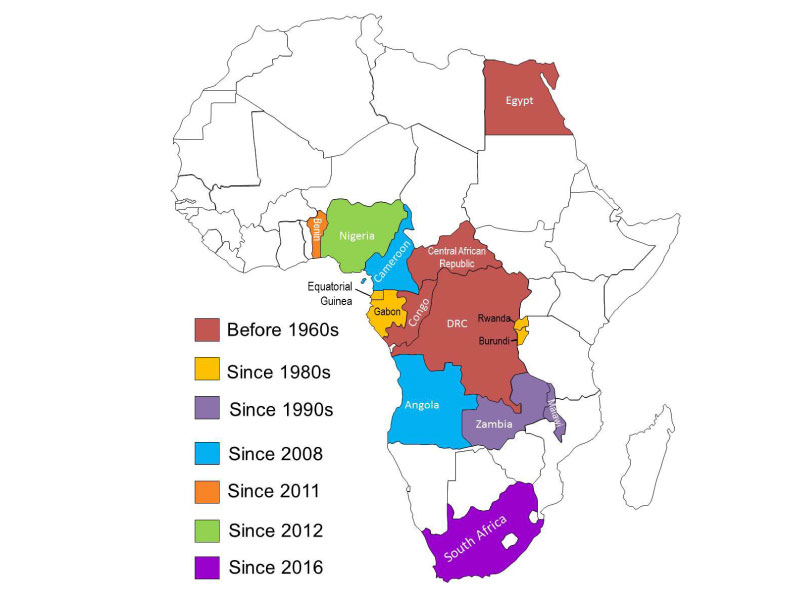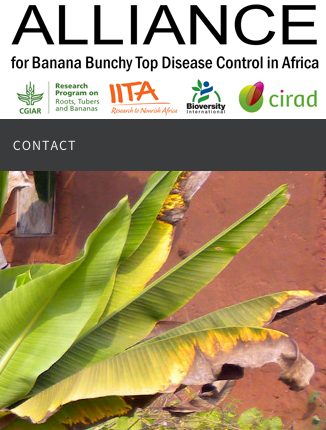Building communities’ capacity to control and recover from the banana disease BBTD

Year of arrival of BBTD. Credit: BBTV Alliance
BBTD is caused by the banana bunchy top virus (BBTV), which invades new fields or regions via the banana aphid Pentalonia nigronervosa or infected planting material. RTB scientists are consequently studying the virus and aphid vector while working with national partners and communities to establish systems for producing disease-free banana planting material. They’ve improved knowledge of the disease through laboratory research, field trials and surveys at pilot sites in Nigeria, Benin, Gabon, Cameroon, Congo, DR Congo, Malawi and Burundi to determine the extent of BBTD’s impact.
“We now understand much better the serious nature of this threat,” said Charles Staver, a senior scientist at Bioversity, coordinator of the BBTD initiative and RTB project leader. He explained that the disease has been reported in 14 countries in SSA, and while incipient in countries such as Benin and Nigeria, it is widespread in the Congo River Basin. Researchers at the University of Kisangani estimated that BBTD threatens the banana and plantain production of over 5 million households in the DR Congo, whereas researchers in Burundi estimated that the disease has reached 500,000 farms. Staver warned that the disease is spreading in West Africa and is poised to advance further into East Africa.
The alliance has raised awareness of this threat while working at nine pilot sites in eight countries – representing the major banana production systems in SSA – to test strategies for re-establishing banana production in areas where BBTD has devastated the crop. Results from pilot sites show that the most effective strategy is to uproot all banana plants, maintain farms free of banana for at least six months, and replant with BBTV-free planting material while maintaining banana-free buffer zones around the replanted fields. If these practices are followed, banana production can be recovered for at least two or three harvests. However, the disease usually re-invades the farm, indicating a need for further research.
From the onset of work at the pilot sites, RTB researchers collaborated with local partners on gender research to better understand the roles of men and women in areas such as community decision-making and farm management. Staver explained that cross-site lessons learned from that gender research will enhance impending efforts to scale out successful recovery strategies.
“RTB partners have catalyzed commitments from African governments, the FAO and the Bill & Melinda Gates Foundation to strengthen efforts to study and control BBTD,” affirmed IITA virologist Lava Kumar. He gave the example of collaboration between IITA and several Nigerian government agencies to launch a “Stop Bunchy Top” campaign in early 2016 to halt the disease’s advance within Nigeria.
Kumar explained that an essential component of such efforts is the ability to detect BBTV in plants and aphids, and RTB has contributed to the development of two new technologies for BBTV detection: a diagnostic test based on loop-mediated isothermal amplification (CT-LAMP) and a recombinase polymerase amplification assay. Plant virologist Marie-Line Iskra-Caruana, of CIRAD, noted that one advantage of the CT-LAMP assay is that it detects the virus in low concentrations, so it is useful for testing planting material and early detection in mature plants.
Bioversity associate scientist Aman Omondi observed that another important achievement is that the RTB initiative has trained representatives of national research institutes, universities and ministries of agriculture in areas ranging from BBTD diagnostics to clean seed systems. As the disease spreads and the RTB researchers develop more tools for controlling it, this critical mass of trained people will lead the battle to defeat BBTD.


